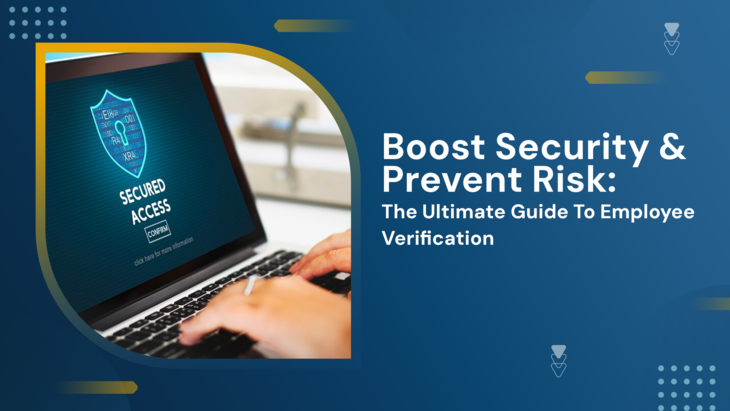In today’s digital age, where businesses rely heavily on their workforce, ensuring employee legitimacy is important. A strong employee verification process safeguards your organization from a multitude of risks, including identity theft, fraud, and infiltration by unauthorized individuals. This comprehensive guide delves into the importance of employee verification, explores the different verification methods available, and outlines best practices for implementing a robust verification program.
Why Employee Verification Matters
Employee verification transcends simply checking references. It’s a meticulous process that confirms an individual’s identity, qualifications, and employment history. Here’s a breakdown of the compelling reasons why pre-employee verification is crucial:
- Enhanced Security: Verification helps weed out fraudulent applicants who might submit fabricated resumes or use stolen identities. This safeguards your organization’s sensitive data and infrastructure from potential security breaches.
- Reduced Risk of Negligence: Verifying an applicant’s work experience and qualifications ensures they possess the necessary skills and knowledge to perform the job effectively. This minimizes the risk of negligence or errors that could cost the company time, money, or reputation.
- Improved Compliance: Certain industries or regulations mandate specific employee verification procedures. Implementing a robust verification program ensures your organization adheres to these compliance requirements and avoids potential legal ramifications.
- Boosted Trust and Morale: A well-verified workforce fosters a sense of trust and security among employees. Knowing colleagues have undergone proper background checks strengthens team dynamics and morale.
- Reduced Onboarding Costs: Hiring the wrong person can be a costly mistake. Verification helps identify unsuitable candidates early on, saving time and resources spent on onboarding and training the wrong fit.
Employee Verification Methods: A Comprehensive Toolbox
There’s no one-size-fits-all approach to employee verification. The ideal method depends on the specific role, industry regulations, and your organization’s risk tolerance. Here’s an overview of the most common employee verification methods:
- Identity Verification:
- Government-Issued ID: Verifying a candidate’s government-issued ID (passport, driver’s license, etc.) confirms their basic biographical information.
- Social Security Number Verification (US): In the US, verifying the Social Security number ensures the candidate’s eligibility to work and helps prevent identity theft. [Note: Regulations around social security number verification can vary depending on location]
- Education Verification: Contacting the educational institutions listed on the applicant’s resume to confirm their attendance, graduation, and degree details.
- Employment Verification: Reaching out to previous employers to verify the candidate’s employment dates, job title, and responsibilities. This can be done through phone calls, emails, or a verification service.
- Reference Checks: Contacting the references provided by the candidate to gain insights into their work ethic, skills, and suitability for the role.
- Professional License Verification: For positions requiring professional licenses (e. g., doctors, lawyers), verifying the license’s validity with the issuing authority ensures the candidate is qualified to practice.
- Background Checks: Background checks delve deeper into an applicant’s history, uncovering criminal records, civil judgments, and other relevant information depending on local regulations and your organization’s needs. Be sure to comply with relevant privacy laws and regulations when conducting background checks.
Additional Considerations
- Third-Party Verification Services: Several companies offer comprehensive verification services that streamline the process and ensure compliance.
- International Verifications: Verifying international candidates requires additional considerations due to varying regulations and procedures in different countries. Consider partnering with a verification service with expertise in global background checks.
Building a Robust Employee Verification Program: Best Practices
Implementing a well-structured employee verification program is crucial for reaping the benefits mentioned earlier. Here are some best practices to follow:
- Develop a Clear Policy: Establish a formal policy outlining your organization’s verification procedures. This policy should specify which verification methods are mandatory for different positions and the acceptable level of detail for each verification step.
- Standardize the Process: Ensure consistency in your verification process across all departments and hiring managers. This reduces the risk of errors or bias and streamlines the onboarding experience for candidates.
- Leverage Technology: Utilize online verification tools and services to expedite the process and improve efficiency. These tools can automate tasks like reference checks and identity verification.
- Maintain Data Security: Store sensitive verification data securely, following data privacy regulations. Restrict access to this information to authorized personnel only.
- Stay Informed: Keep up-to-date with evolving regulations and best practices regarding employee verification. This ensures your program remains compliant and effective.
Remember: Employee verification is an ongoing process. Consider reverifying certain information periodically, especially for positions with high security risks.
The Benefits Outweigh the Costs: Investing in Employee Verification
While implementing a robust employee verification program requires investment in time and resources, the benefits far outweigh the costs. Here’s a closer look at the return on investment (ROI) associated with employee verification:
- Reduced Turnover: A thorough verification process helps identify the right candidates from the outset, leading to better hiring decisions and reduced employee turnover. Lower turnover translates to significant cost savings associated with recruitment, onboarding, and lost productivity.
- Enhanced Productivity: Verifying an applicant’s skills and experience ensures they possess the capabilities to perform the job effectively. This reduces the time and resources spent on training employees who may not be a good fit, ultimately boosting overall productivity.
- Improved Client Satisfaction: A well-verified workforce fosters trust with clients. Knowing that employees have undergone proper background checks reassures clients that their data and projects are in safe hands. This can lead to improved client satisfaction and retention.
- Mitigated Legal Risks: Employee verification helps ensure compliance with labor laws and regulations. A documented verification process can serve as evidence of due diligence in case of legal disputes or lawsuits.
- Stronger Employer Brand: A commitment to employee verification demonstrates your organization’s dedication to security and professionalism. This can attract top talent and strengthen your employer brand in the competitive job market.
Quantifying the ROI:
Calculating the exact ROI of employee verification can be challenging due to the multifaceted benefits involved. However, you can estimate the potential cost savings by considering factors such as:
- Average cost-per-hire: Industry benchmarks can provide a starting point for estimating recruitment and onboarding costs associated with a bad hire.
- Employee turnover rate: Reducing turnover by even a small percentage can lead to significant cost savings.
- Potential legal costs: Employee-related lawsuits can be expensive. Verification helps mitigate these risks.
By taking these factors into account, you can build a compelling business case for investing in employee verification.
Conclusion: Building a Secure Future with Employee Verification
In today’s digital landscape, where cyber threats and data breaches are prevalent, employee verification plays a critical role in safeguarding your organization. A well-designed verification program not only protects your company from security risks and fraud but also fosters a culture of trust and strengthens your employer brand. By implementing the best practices outlined in this guide, you can build a robust verification program that delivers a positive return on investment and empowers you to build a secure and successful future for your organization.
FAQ’s
Q1. What information is typically verified during the employee verification process?
The information verified depends on the position and your organization’s policy. However, common elements include:
- Identity verification (government-issued ID)
- Education verification (attendance, degree details)
- Employment verification (previous employers, job titles, dates)
- Reference checks (insights into work ethic and skills)
- Professional license verification (for licensed professions)
- Background checks (criminal records, civil judgments)
Q2. Is employee verification mandatory?
Employee verification is not universally mandatory, but some industries or regulations may require specific verification procedures. Regardless of legal mandates, it’s a highly recommended practice for mitigating risks and ensuring a qualified workforce.
Q3. Who typically conducts employee verification?
Verification can be done internally by your HR department or typically conducted by private investigators or reputable detective agency in Delhi. These professionals specialize in thorough background checks and screening processes to ensure the authenticity and credibility of potential employees. Employers often rely on their expertise to verify educational qualifications, employment history, criminal records, and other relevant information to make informed hiring decisions and maintain workplace safety and security.
Q4. How long does the employee verification process take?
The timeframe can vary depending on the methods used and the complexity of verification (e.g., international checks). Simple verifications might take a few days, while comprehensive checks with background investigations could take a week or longer.
Q5. What are the legal considerations for employee verification?
Be sure to comply with relevant privacy laws and regulations when conducting background checks. In the US, for instance, the Fair Credit Reporting Act (FCRA) outlines specific requirements for obtaining employee consent and using background check information.
Q6. Can an applicant deny verification of their employment history?
An applicant can choose not to authorize verification of their employment history. However, this could raise red flags and potentially harm their candidacy. It’s best practice to have a transparent conversation with the applicant about the verification process.


